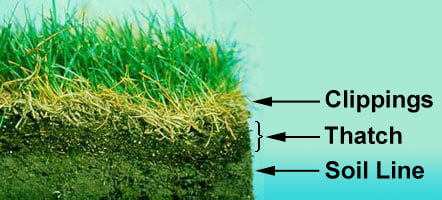What to do About Thatch in Your Lawn
Contrary to what most people believe, thatch is not simply grass clippings that aren’t decomposing. Clippings can add to a thatch problem once the problem exists, but generally, clippings are very beneficial to the lawn when you have a healthy, bioactive soil. They decompose and recycle in as little as two weeks and help provide nutrients and organic matter.
Thatch is actually a matted layer (of roots, stems, blades, runners, and clippings) that forms on top of the soil. You might describe it as a lawn that is growing into itself rather than into the soil. If you try to poke your finger through your lawn and into the soil and find that there is a matted, vegetative barrier of about 1/2 inch thick or more, you have a real thatch condition. We’ve seen thatch as thick as 3 inches.
Here is a diagram that represents thatch pretty well.

The Problem with Thatch in Your Lawn
Thatch is a very undesirable condition to have because by its nature it creates a barrier between the roots of your grass and the soil. You will therefore have a weaker lawn that will be more prone to disease, insects, and winter kill. Another problem is that the thatch will act like a sponge to absorb rain or watering. Unless the water is very heavy, it may never actually get through the thatch and into the soil. This means the soil eventually dries out and the grass roots will have to grow into the thatch layer itself—where there is some moisture—instead of into the dry soil. And this will only add more to the thatch layer. And it gets worse from there.
To help get water through the thatch layer and into the soil, put on a light application of Aerify, 1/4 ounce per 1000 sf, before watering. The Aerify will then go to work on the soil. If you do this every week or two you won’t need any other Aerify applications. You should also occasionally test to see how deep your water is penetrating by cutting into the soil with a spade and just looking to see if the soil is moist or not.
There can be a few reasons for thatch forming on some lawns. But the most obvious reason, and what a thatch condition usually indicates, is that there is something wrong with your soil. It is not bioactive or healthy enough to promote the decomposition of dead organic matter. Your soil is not teeming with micro-life: it is “dead”, or sterile. Compaction, clay, and poor pH (too acidic or alkaline), will all discourage bioactivity. And if you’ve used a lot of conventional lawn fertilizers that are high in chlorides or salts (see #4 below), or you’ve used excessive pesticides. you may have killed off a lot of beneficial soil micro-life yourself. Lack of earthworms is an indicator of a bad soil. In fact, you’ll rarely see thatch where earthworms are abundant because along with being great soil aerators, they are one of nature’s best thatch digesters.
Our Nature’s Magic is a great soil detoxifier and salt buffer due to its high Humic Acid content. It will also help stimulate the growth of beneficial microbes that both prevent thatch and help decompose it as well. For the purpose of soil detoxification, and to encourage thatch decomposing microbes, do an initial application of Nature’s Magic at 4 ounces per 1000 sq ft. Mix in 1 oz. of Aerify for faster results. Or, try our combination product, Aerify Plus.
The Solution to Thatch in Your Lawn
If you have real thatch, a dethatching machine or power rake will not do much to help. It would barely scratch into the matted layer, or worse, it might rip up your lawn. The real solution to thatch, and the best way to prevent it, is to improve your soil so it is aerated and bioactive enough to get the thatch to decompose. When you do this, the thatch will gradually begin to break down from the bottom (where it is in contact with the soil) up. It will turn into rich, dark humus. It can take a couple of years to fully break up the thatch, but it will happen.
Here are some other factors and tips to help you get rid of thatch through decomposition:
- You need to keep the soil moist underneath the thatch layer. When it dries out, decomposition ceases. Less frequent, heavy waterings are best. If you water too often and keep the whole thatch layer moist all the time, you are asking for trouble with fungus. Also, you want to encourage the roots to go down into the soil for water and not stay in a wet thatch layer.
- Collect your clippings until the thatch problem is handled. They will only add to the thatch. But once the thatch layer is resolved, we highly suggest leaving your clippings. Check out our series on How to Mow Your Lawn for more information.
- Test the pH and add Lime as needed. If your soil is acidic it could dramatically slow down or even prevent thatch decomposition. Our Liquid Lime is the fastest way to add lime/calcium to plants and soils, and it’s sugar chelated so that the nutrients are unlocked and immediately available.
- Increase thatch degrading bioactivity with our Biological Dethatcher. It contains specific microbes and enzymes designed to generate and accelerate thatch decomposition. Regular applications throughout the season will help breakdown your thatch layer and turn it into valuable humus.
- Your lawn will need regular fertilizing because soil microorganisms need nitrogen to decompose thatch. You want to avoid any fertilizers that contain muriate of potash (potassium chloride) because chlorides can be harmful to soil life. Straight organic granular fertilizers may not be the best choice here because, unless they are water soluble, they will sit on top of the thatch layer and be very slow to break down and release their nutrients. After all, a lot of the thatch is already organic matter that isn’t breaking down fast enough.
- Liquid fertilizers may be the best idea when thatch exists. They will go right through to the soil when watered in, and won’t get stuck in the thatch. Monthly applications of a salt-free and chlorine-free liquid fertilizer (like our Bio-Enhanced 16-4-8) will provide more available nitrogen and therefore will promote faster thatch decomposition.
Let us know how it goes!


